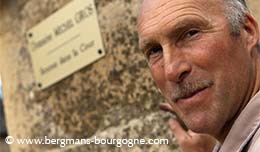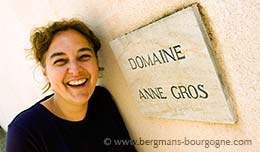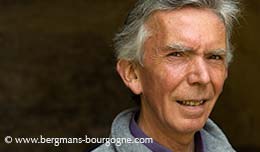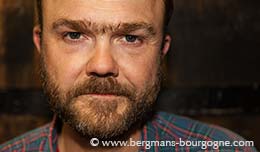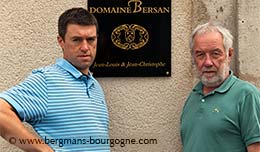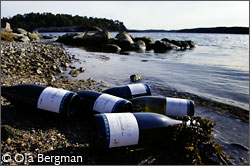
hey first met in a rugby field in Hong Kong. Manoël Bouchet and Daniel Connolly, a Burgundian and an Englishman, are the new generation of négociants in Burgundy. They are smaller than the traditional négociant, they have a different approach and the message is to keep it simple.
Adamas is Burgundy's first Anglo-French négociant, something that makes things a bit difficult when it comes to interviews. Especially when the interviewer is based in Sweden, 2000 kilometres from Beaune and Burgundy. While Manoël Bouchet is based in Beaune Daniel Connolly runs his part of the business some 1400 kilometres further up north, in Fife, Scotland. Not exactly next-door to Sweden that either.
In order to make this work a case of wine was shipped to Sweden for photos by the Baltic Sea and tasting. Then all three of us had a chat over the phone talking about traditional versus modern Burgundy, rugby and the difficulties when starting out fresh as a négociant in Burgundy.
– We made an agreement that we would produce our own wines one day, explains Daniel Connolly.
In his case the Burgundian adventure began in 1995 when he ended up harvesting in Mercurey on the Côte Chalonnaise in Burgundy.
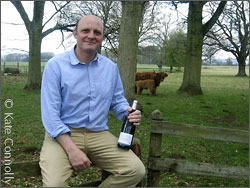
– I was working for a wholesaler in London; in the warehouse stacking boxes, driving the van and delivering to restaurants. I thought there must be more to the wine business than stacking boxes. My mother mentioned that she has a cousin who makes wine in Burgundy. My grandmother's sister, an English lady, married the Baron Thénard. I was vaguely aware of Burgundy, but didn't really have an understanding about what it was.
– I drove down there and it was fantastic. I really fell in love with the place.
Daniel Connolly ended up staying for two and a half years in Burgundy, working for Maison Louis Latour. On the rugby pitch in Beaune he once again bumped into Manoël Bouchet.
– Three years ago we met up in San Fransisco, says Manoël Bouchet. We had a long weekend together and we said "OK, let's give it a go and try to do something in the wine industry". We wanted to do something different from the others, something with a different approach.
By then both had gained more experience in the wine business, Manoël Bouchet at Tonnellerie Rousseau and Daniel Connolly at Bibendum, the London wine merchant, and Quinta do Noval, the port wine producer.

– Our priority was to make a range of classic Burgundy wines, explains Daniel Connolly. The style we're after is a really crisp, fresh and classic Burgundy style with a limited use of oak.
– We also looked very carefully at the other side of the business, which is selling Burgundy, he continues. We took the view that a lot of the Burgundy domaines have taken a very traditional, old-fashioned approach in marketing Burgundy – how the labels look and how they go about things, which is fine for the connoisseurs and people who understand Burgundy. But I think some consumers find that approach quite intimidating and a little bit confusing.
Therefore the Adamas labels are clean and simple. For the premier cru wines there is no mention of specific climats – they are simply Puligny-Montrachet Premier Cru and Pommard Premier Cru. The wine portfolio covers the whole range from the generics – Bourgogne Blanc and Bourgogne Rouge – up to the grand cru of Montrachet.
– We are just trying to merge together the tradition of Burgundy, 2000 vintages, with more modern tools, which fit better into the cultural environment and the expectations of the new generation of consumers, says Manoël Bouchet.
– We are not trying to reinvent the wheel, to create something really new. We are just trying to work with what we have at our disposition – great quality wines from the mother of pinot noir and chardonnay, using modern tools such as the internet to communicate.

As a négociant Adamas buys finished wine from a number of sources in Burgundy. They keep a close relationship with the winemakers in order to maintain the house style. Today the annual production is 25 000 bottles. The target is to reach 100 000 bottles in three years time.
– We are doing a selection of wines, we are not winemakers, says Manoël Bouchet. I taste the wines and I follow up with the winemakers. We work with four main producers. Together they account for 85 percent of the wine. We are also talking to another four or five producers that work with appellations that we might add in the future.
– The easiest appellations to sell are Chassagne-Montrachet and Puligny-Montrachet, but you can't source them. That's the problem in Burgundy; something that is easy to sell also means that there is a huge demand.
– So we are trying to be right in the middle. Meursault is a good appellation. It's a big village with large volumes and it's well recognized worldwide. Beaune could be in this position. It's a bit weak in terms of notoriety, but it has a great potential in terms of quality of the wines, volumes and value for money.
– We try to focus on the well-known appellations where we can guarantee a consistent supply of good quality wine, says Daniel Connolly. And also on appellations that people are familiar with. Nothing too complicated and too difficult to pronounce.
This excludes appellations such as Pernand-Vergelesses, Auxey-Duresses, Saint-Aubin, Chorey-lès-Beaune and Morey-Saint-Denis.
– We are avoiding these appellations because at the moment we don't have the money or the power to push them, says Manoël Bouchet. To do that you need a strong brand. Maison Louis Jadot and Bouchard Père et Fils don't have a problem selling the smaller appellations because their brand is strong and people trust it.
© 2008 Ola Bergman










